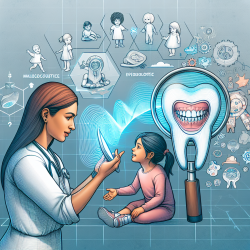In the realm of speech-language pathology, making data-driven decisions is paramount. A recent epidemiological study titled "Malocclusions and oral dysfunctions: A comprehensive epidemiological study on 359 schoolchildren in France" by Borsa et al. (2023) provides critical insights that can significantly enhance therapeutic outcomes for children. The study's findings highlight the prevalence of malocclusions and oral dysfunctions, offering valuable information that practitioners can leverage to improve their skills and intervention strategies.
Key Findings and Their Implications
The study examined 359 schoolchildren, revealing that 88% exhibited malocclusions, with a significant number also displaying swallowing (87%) and respiration (42.7%) disorders. The presence of malocclusions was statistically linked to the low position of the tongue at rest, abnormal swallowing, and improper mouth breathing. These findings underscore the importance of early identification and intervention in managing these conditions.
Practical Applications for Speech-Language Pathologists
Based on the study's outcomes, speech-language pathologists can enhance their practice by focusing on the following areas:
- Early Screening and Diagnosis: Regular screening for malocclusions and oral dysfunctions in school-aged children can lead to early diagnosis and timely intervention. Incorporating routine checks for tongue position, swallowing patterns, and breathing modes can be beneficial.
- Interdisciplinary Collaboration: Working closely with orthodontists and other healthcare professionals can provide a holistic approach to managing these conditions. Collaborative efforts can ensure comprehensive care and better outcomes for children.
- Targeted Therapy Techniques: Developing targeted therapy techniques that address specific dysfunctions such as abnormal swallowing and improper mouth breathing can improve the effectiveness of interventions. Tailoring therapy to address these underlying issues can lead to more successful outcomes.
- Parental Education: Educating parents about the signs of malocclusions and oral dysfunctions and the importance of early intervention can empower them to seek timely care for their children. Providing resources and guidance on maintaining oral health can also be beneficial.
Encouraging Further Research
While the study provides valuable insights, it also highlights the need for further research in this area. Investigating the long-term impact of early intervention on malocclusions and oral dysfunctions can provide more robust data to guide clinical practice. Additionally, exploring the genetic and environmental factors contributing to these conditions can help develop more effective prevention and treatment strategies.
Conclusion
The study by Borsa et al. (2023) offers crucial information that can significantly enhance the practice of speech-language pathologists. By implementing the study's findings and encouraging further research, practitioners can improve their skills and create better outcomes for children. To read the original research paper, please follow this link:
Malocclusions and oral dysfunctions: A comprehensive epidemiological study on 359 schoolchildren in France.










